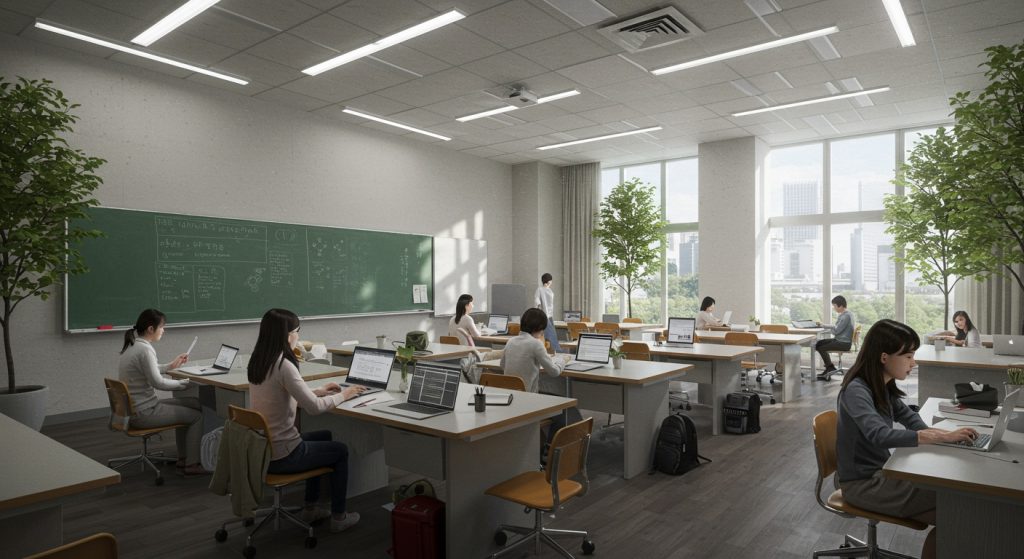Japan, a nation where ancient temples meet futuristic skyscrapers, offers a compelling landscape for aspiring architects. The country’s unique blend of traditional craftsmanship and cutting-edge technology shapes architectural education, fostering designers who can seamlessly integrate historical context with modern innovation. With increasing global focus on sustainable urbanism and resilient design, understanding architectural principles through the lens of Japan’s earthquake-prone environment provides invaluable insight. This exploration delves into the leading Japanese institutions cultivating this expertise, spotlighting their diverse pedagogical approaches, from hands-on studio work emphasizing materiality to theoretical frameworks examining spatial dynamics. Showcasing how each prepares graduates to shape the built environment of tomorrow.
Understanding Architectural Education in Japan
Architectural education in Japan is deeply rooted in both tradition and innovation. Japanese architecture is celebrated globally for its minimalist aesthetics, innovative use of materials. Integration with the natural environment. Degree programs in architecture in Japan typically emphasize a holistic approach, blending theoretical knowledge with practical skills. Students learn about architectural history, structural engineering, design principles. Urban planning, often with a strong focus on sustainability and disaster resilience – crucial considerations in a country prone to earthquakes and other natural disasters.
Key aspects of architectural education in Japan include:
- Emphasis on Design Studios: A significant portion of the curriculum involves studio work where students develop design proposals and models under the guidance of experienced faculty.
- Integration of Traditional Techniques: Many programs incorporate elements of traditional Japanese architecture, such as the use of wood, paper screens (shoji). Tatami mats.
- Focus on Sustainability: Given Japan’s commitment to environmental protection, sustainable design practices are often integrated into the curriculum.
- Collaboration with Industry: Many institutions have partnerships with leading architectural firms, providing students with opportunities for internships and real-world experience.
University of Tokyo
The University of Tokyo (Todai), consistently ranked among the top universities globally, offers a prestigious architecture program within its Department of Architecture. The program emphasizes both theoretical and practical aspects of architecture, encouraging students to develop innovative solutions to contemporary challenges. The faculty includes renowned architects and researchers who are at the forefront of their fields.
Key Features:
- Comprehensive Curriculum: The curriculum covers a wide range of topics, including architectural design, history, theory, structural engineering. Urban planning.
- Research Opportunities: Students have ample opportunities to participate in cutting-edge research projects, often collaborating with faculty members on real-world problems.
- International Exchange Programs: The University of Tokyo has partnerships with leading universities around the world, allowing students to participate in exchange programs and gain international experience.
- Emphasis on Sustainable Design: The program places a strong emphasis on sustainable design principles, reflecting Japan’s commitment to environmental protection.
Notable Alumni: Many graduates of the University of Tokyo’s architecture program have gone on to become leading architects, academics. Policymakers in Japan and abroad.
Kyoto University
Kyoto University, another of Japan’s leading universities, offers a distinguished architecture program known for its emphasis on research and innovation. The program encourages students to explore the intersection of architecture, technology. Society, preparing them to address the complex challenges facing the built environment.
Key Features:
- Interdisciplinary Approach: The program fosters an interdisciplinary approach, encouraging students to collaborate with researchers from other fields, such as engineering, science. Humanities.
- State-of-the-Art Facilities: Kyoto University boasts state-of-the-art facilities, including advanced design studios, digital fabrication labs. Research centers.
- Focus on Traditional Japanese Architecture: The program incorporates elements of traditional Japanese architecture, allowing students to learn about the history and cultural significance of Japanese design.
- Strong Industry Connections: Kyoto University has strong connections with leading architectural firms and construction companies, providing students with opportunities for internships and job placements.
Research Strengths: Kyoto University is particularly strong in research areas such as sustainable building design, disaster prevention. Urban regeneration.
Tokyo Institute of Technology (Tokyo Tech)
The Tokyo Institute of Technology (Tokyo Tech) is renowned for its focus on science and technology. Its architecture program reflects this emphasis. The program combines architectural design with engineering principles, preparing students to create innovative and sustainable buildings. Tokyo Tech is a great choice for students looking at Top Affordable Colleges for Civil Engineering: A Global Perspective.
Key Features:
- Engineering-Focused Curriculum: The curriculum integrates architectural design with structural engineering, building science. Construction management.
- Hands-on Learning: Students have opportunities to participate in hands-on projects, such as designing and building prototypes.
- Advanced Technology: Tokyo Tech provides access to advanced technologies, such as building insights modeling (BIM) software and digital fabrication equipment.
- Collaboration with Industry: The program has strong ties with leading construction companies and architectural firms, providing students with opportunities for internships and industry-sponsored research projects.
Specializations: Tokyo Tech offers specializations in areas such as structural design, environmental engineering. Urban planning.
Waseda University
Waseda University offers a well-regarded architecture program within its Department of Architecture. The program emphasizes a balance between theoretical knowledge and practical skills, preparing students for careers in architecture, urban planning. Related fields. Waseda University distinguishes itself through its global outlook and commitment to fostering creativity and innovation.
Key Features:
- Comprehensive Design Studios: The program features comprehensive design studios where students develop design proposals and models under the guidance of experienced faculty.
- International Perspective: Waseda University has a strong international focus, with opportunities for students to participate in exchange programs and study abroad.
- Emphasis on Social Responsibility: The program encourages students to consider the social and environmental impact of their designs.
- Strong Alumni Network: Waseda University has a strong alumni network, providing students with valuable connections and career opportunities.
Course Variety: Waseda offers a diverse range of courses covering architectural history, theory, design. Technology.
Keio University
Keio University offers an architecture program that emphasizes creative thinking and problem-solving skills. The program encourages students to explore the intersection of architecture, art. Technology, preparing them for diverse careers in the design industry.
Key Features:
- Focus on Innovation: The program fosters a culture of innovation, encouraging students to experiment with new ideas and technologies.
- Interdisciplinary Collaboration: Students have opportunities to collaborate with students from other disciplines, such as art, engineering. Business.
- Design Thinking Approach: The program emphasizes a design thinking approach, encouraging students to comprehend the needs of users and develop solutions that are both functional and aesthetically pleasing.
- Entrepreneurial Opportunities: Keio University provides resources and support for students who are interested in starting their own design businesses.
Industry Connections: Keio University has strong connections with leading design firms and technology companies, providing students with valuable internship and job opportunities.
Selecting the Right Program
Choosing the right architecture program is a crucial decision that can significantly impact your future career. When selecting a program, consider the following factors:
- Curriculum: Review the curriculum carefully to ensure that it covers the topics that are most crucial to you.
- Faculty: Research the faculty members and their areas of expertise.
- Facilities: Consider the availability of state-of-the-art facilities, such as design studios, digital fabrication labs. Research centers.
- Location: Consider the location of the university and its proximity to architectural landmarks and design firms.
- Cost: Evaluate the tuition fees and living expenses associated with each program.
- Career Opportunities: Research the career opportunities available to graduates of each program.
Comparing Key Institutions
Here’s a comparison table highlighting some of the key differences between the institutions mentioned above:
| Institution | Focus | Strengths | Notable Features |
|---|---|---|---|
| University of Tokyo | Comprehensive Architecture | Research, International Exposure | Emphasis on sustainability, strong alumni network. |
| Kyoto University | Research and Innovation | Interdisciplinary Collaboration, Traditional Japanese Architecture | State-of-the-art facilities, strong industry connections. |
| Tokyo Institute of Technology (Tokyo Tech) | Engineering & Technology | Engineering-focused curriculum, Hands-on learning | Advanced technology, industry collaboration. |
| Waseda University | Balanced Approach | International Perspective, Social Responsibility | Comprehensive design studios, strong alumni network. |
| Keio University | Innovation & Design Thinking | Interdisciplinary Collaboration, Entrepreneurial Opportunities | Focus on innovation, strong industry connections. |
This table provides a quick overview to help prospective students differentiate between the programs and identify those that best align with their academic and career goals.
Conclusion
The journey to architectural mastery in Japan is paved with unique challenges and unparalleled opportunities. You’ve explored some of the nation’s leading institutions, each with its distinct focus, from traditional design principles to cutting-edge sustainable technologies. Choosing the right path requires careful consideration of your personal ambitions and learning style. Approach 5: The Success Blueprint Remember, a key takeaway is the emphasis on collaboration and hands-on experience prevalent in Japanese architectural education. Success hinges not just on academic prowess. On your ability to integrate into studio culture and embrace the unique design ethos. To implement your choice, research faculty expertise aligned with your interests, thoroughly review studio projects. Even consider networking with current students. This groundwork will significantly increase your chances of admission and future success. Embrace the challenge, stay motivated. Build your dream career.
FAQs
So, I’m thinking about studying architecture in Japan. Which universities are, like, really good?
Okay, great choice! Japan has some amazing architecture programs. For top-tier options, definitely look into the University of Tokyo (Todai), Kyoto University. Tokyo Institute of Technology (Tokyo Tech). They’re known for their rigorous academics and research opportunities. Waseda University is also a strong contender, particularly for its international programs.
Are the application processes for these Japanese universities different for international students?
You bet! They usually have a separate application track designed specifically for international students. You’ll likely need to demonstrate Japanese language proficiency. The application requirements can be a bit more involved compared to domestic students. Definitely check each university’s website for the specifics, as they can vary quite a bit.
What kind of portfolio should I prepare if I want to get into one of these schools?
Your portfolio is super essential! It should showcase your design skills, creativity. Problem-solving abilities. Include a range of projects that demonstrate your artistic and technical skills. Think sketches, drawings, models (even photos of models). Any other work that highlights your potential. Presentation matters, so make sure it’s well-organized and easy to interpret.
Do I need to know Japanese fluently to study architecture there?
While some programs are offered in English (especially at the graduate level), having a solid understanding of Japanese is generally a huge advantage, both academically and socially. Even if the courses are in English, you’ll still need to navigate daily life, interact with professors and classmates. Potentially work on projects in Japan. So, consider brushing up on your Japanese skills!
How long are the architecture degree programs in Japan, generally?
Typically, a bachelor’s degree (undergraduate) in architecture takes four years. If you’re aiming for a more specialized master’s degree (graduate), that’s usually an additional two years. Ph. D. Programs can vary. You’re looking at another three to five years on top of your master’s.
Besides the big names, are there any other architecture schools in Japan worth considering?
Absolutely! While Todai, Kyoto. Tokyo Tech are prestigious, don’t overlook places like Keio University, Osaka University. Tohoku University. They offer excellent architecture programs with unique specializations and research opportunities. Plus, sometimes the smaller, less well-known schools can offer a more personalized learning environment.
What about job prospects after graduating with an architecture degree from Japan?
Job prospects are generally good, especially if you’ve gained relevant experience through internships or research projects. Many graduates find work in architectural firms, construction companies, or government agencies in Japan. Of course, your Japanese language skills will play a significant role in your job search. Some graduates also pursue opportunities internationally, leveraging their unique knowledge of Japanese architecture and design.

